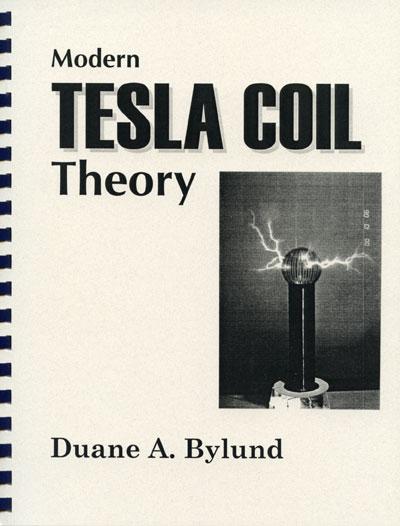
Nikola Tesla Books
Modern Tesla Coil Design Theory
This had its beginnings when I made my solid state Tesla coil with AFC in early 1989. I started to write an article on it but there was so much information collected that the article just grew into this book. My main interest has been in how Tesla coils work, not in making the biggest coil possible. For this reason I have had very little experience with high powered Tesla coils. The Tesla coils used for examples in this book could be classified as tabletop units. I do not claim to be an expert on Tesla coils but I want to share what I have learned about them with other people. I hope this information will be of some use in understanding how Tesla coils work.
Chapter one is about RLC circuits. Most of the information in this chapter is common material. However, this chapter was written specifically with Tesla coils in mind and it gives some important information that is needed later on in the book. There is a lot of information that is covered very briefly and the references at the end of the chapter can be consulted if needed.
Chapter two gives a basic understanding of transmission lines and antennas. This information is also common material but it was written here with an application to Tesla coils as the final objective.
Chapter three is titled “Tesla Secondary Coils.” Tesla's original Tesla coil used a capacitive discharge circuit to develop high voltages in a secondary coil (the secondary coil is actually a resonant RLC circuit). Since that original Tesla coil other methods have been used to get power into the secondary coil, such as vacuum tube oscillators. These are known as vacuum tube Tesla coils. In Modern Tesla Coil Design Theory, some of the circuitry employs several different secondary coils (such as the secondary of ferrite transformers etc.). For this reason, the coil that is operating in a resonant mode, for the purpose of developing high voltages, is called the Tesla secondary coil. Chapter three is about this coil. Most of the information in this chapter comes from my own experiments.
Chapter four is about capacitive discharge Tesla coils. More information is probably known on this type of Tesla coil than any other. However, the capacitive discharge Tesla coil is probably the most complex and less understood. Capacitive discharge Tesla coils are very similar to early wireless telegraph spark transmitters and books on early wireless contain a wealth of information on this subject.
Chapter five is about vacuum tube Tesla coils. The only difference between a capacitive discharge Tesla coil and any other type is the way that energy is introduced into the Tesla secondary coil. The vacuum tube Tesla coil is basically the same as a vacuum tube radio transmitter but the Tesla secondary coil is used for a load rather than an antenna (the Tesla secondary coil can be thought of as a non-radiating antenna as indicated in chapter 3). Good sources of information on this subject can be found in books relating to radio transmitters.
Chapter six is about transistor Tesla coils. The transistor Tesla coil described in this book may be the most efficient Tesla coil ever developed. The efficiency may be upwards to 95% in converting 60 cycle energy into high frequency energy in the Tesla secondary coil. The transistor Tesla coil provides very good results. The capacitive discharge Tesla coil stores energy in the capacitor over a period of time and then dissipates this energy in a short period of time in the form of a corona discharge, thus developing a very high peak power level. Transistor Tesla coils, when operating in the pulsed AC mode, store energy in the Tesla secondary coil itself over a relatively long period of time to be dissipated in a very short period of time, thus creating very large peak power levels also. My first transistor Tesla coil was developed from a 200 watt switching power supply out of an IBM AT compatible computer.
You will find lots of theory in this document that may not be generally known, including:
1. Corona shields that help eliminate eddy currents.
2. The use of counterpoises with the Tesla secondary coil.
3. The use of LEDs along the length of a Tesla secondary coil to show the different current loops and nodes.
4. Energizing several different Tesla secondary coils from the same source at the same time.
5. The use of odd shaped Tesla secondary coils, like the figure 8.
6. The transistor Tesla coil. High voltage transformers have been developed (like the flyback transformer in a television set) but they are different than the transistor Tesla coil that is described in this book. The transistor Tesla coil uses direct coupling to the secondary coil instead of the normal magnetic coupling.
7. A Tesla coil that has automatic frequency control (AFC).
8. An idea for a rotary electric field Tesla coil system. This idea combines two of Tesla's greatest inventions into one.
